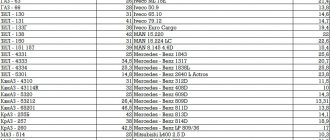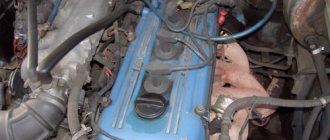In April 2013, GAZ began production of its new light-duty vehicle GAZelle-Next, designed to expand the range of the plant's products on the Russian market. The car was highly appreciated not only in the Russian Federation, but also on the international market - in 2014, all the necessary documents were received for it to be sold in the EU, and production began in Turkey. The main differences of the new model were a completely new and modern design, the use of modern casting and stamping technologies, the installation of more economical and powerful power units, as well as a number of other improvements. Today, GAZelle-Next is produced in various versions, ranging from flatbed vehicles and all-metal vans to buses and special equipment.
GAZelle-Next 2.7 petrol
Since 2014, GAZelle-Next vehicles have been equipped with a UMZ A274 EvoTech 4-cylinder gasoline injection engine of Euro-4 standard. It produces 107 PS of power and has a peak torque of 220 Nm and is mated to a 5-speed manual transmission.
Fuel consumption of Gazelle-Next is 2.7 petrol per 100 km. Reviews
- Sergey, Petrozavodsk. I regret that I didn’t listen to my friend and didn’t immediately take the version with LPG, but chose the one with a gasoline engine. Consumption in cities, even with an incomplete load, is stable at 18 liters per 100 km. I have the all-metal van version.
- Peter, Novosibirsk. The car was purchased for work in the spring of 2016. In six months I have already clocked up 18,000 km. Overall, I’m happy with the car - Next has nothing in common with the previous GAZelle, the assembly is much better, the cabin is of high quality, it breaks much less. There is only one minus - the consumption of 16 liters in the city does not make me happy at all.
- Anatoly, St. Petersburg. For me, the speed qualities in a car like the GAZelle Next are completely unimportant - the main thing is that it has normal load capacity, does not break down and is comfortable to drive - I drive all day. My Gazelle copes with its task with a bang. Consumption with a load in the city is about 20 liters - but it cannot be less.
- Denis, Sverdlovsk. I bought it in 2016 with the maximum configuration. In the city, the engine's power is enough for the eyes, but on the highway, of course, there are not enough horses. Consumption on the highway is 10 liters, in the city - 15-16 liters - these are average figures, if the load is full, then of course the consumption is higher.
- Igor, Krasnodar. In principle, I am satisfied with my Gazelle-Next, but sometimes, especially if fully loaded, 107 horses is not enough. You can also feel this if you are in a hurry - you press the gas to the floor, but the dynamics are weak. Well, on the other hand, it’s still a truck, not a sports car. As for consumption - from 15 liters in the city, or even more.
- Vladimir, Moscow. This is already my third GAZelle - and I’ll tell you that this is probably the best and most successful of all. First of all, it is necessary to note the cabin - much more comfortable than in previous versions, spacious and well designed. Consumption in the city is up to 20 liters with Moscow traffic jams, on the highway - 10-12 liters.
- Alexey, Rostov. The car is good - the most normal option for work. The interior is comfortable, there is plenty of room in the back, the engine is economical - for a truck 15-17 liters in the city I consider consumption quite normal, my Camry with a 1.6 liter engine consumes 10-11, but here the engine is 2.7 and the weight is several times greater.
Other cars: Lexus RX350 fuel consumption owner reviews
Real fuel consumption of GAZelle-Next according to reviews from car owners
Unfortunately, very often it turns out that the actual consumption of diesel or gasoline differs significantly from the data provided by the manufacturer. Naturally, sometimes this leads to the fact that operating such a vehicle becomes extremely unprofitable. How are things going with this characteristic of a domestic light-duty truck:
Volume – 2.7 liters
The gasoline power unit has a power of 107 horsepower. The engine life is 400 thousand kilometers. What can you learn about its consumption from reviews of car owners:
- Alexei. Rostov. I purchased it in 2014, immediately with a new gasoline engine. Before this, I had been driving a regular Gazelle for a long time, so I immediately felt some improvement in comfort, and most importantly, a significantly larger amount of free space in the cabin. The consumption, of course, does not correspond to the declared one. In my city it turns out to be about 15, outside of it - all twenty.
- Vladimir. Leningrad region. I have several stores in the region, so having my own truck is very important for me. The choice fell on Next. Of course, this engine clearly lacks power, however, it copes with all the tasks assigned. Outside cities in the summer I use about 14 liters of gasoline, in the winter – about 17.
- Innocent. Novosibirsk I regretted it almost immediately after I took it. No, the main characteristics and price of the car itself are completely satisfactory. The problem is the gasoline engine, which consumes a huge amount of fuel every day - up to twenty liters for every hundred kilometers!
- Denis. Sverdlovsk Personally, I’m happy with everything. A very good car for delivering goods. The size of the salon is simply amazing - and for me this is very important. Therefore, I don’t worry too much about the performance of my engine. Although I measured it several times just for fun - around the city it comes out to about 15-16 liters.
- Anatoly. Krasnodar. I took it in the maximum configuration. I went to the factory specifically to get a better selection. The result is that I got exactly what I wanted. Personally, with my version, fuel consumption comes out to be very acceptable - in the city it’s only 13, of course, if I don’t sit in traffic jams for hours, on the highway, if the road is good, it’s a stable ten.
Judging by people's reviews, the main problem of this car is precisely the serious excessive consumption of fuel, which significantly exceeds the data announced by official sources.
Volume 2.8 liters
Diesel engines are presented on the Russian light-duty truck in two versions: the Chinese Cummins with a power of 120 horsepower, and the Russian YaMX with a power of 149 horsepower. What’s most interesting is that the official consumption rates for both engines are completely the same. What do ordinary car enthusiasts say about them in their reviews:
- Sergey. Yaroslavl. I have an option with a Chinese Cummins engine. And the Chinese have clearly learned how to do a lot, including power units. I've been using the car for three years now. During this time, the engine has never failed. I am very pleased with its efficiency: on the highway - only eight liters of diesel fuel, in the city - around 10.
- Victor. Rostov. The boss took the Gazelle Next bus to the enterprise to transport people to various events. Initially, they were extremely wary of this acquisition. But a year of operation forced us to radically change our minds. In all the troubles we have been in with this vehicle, we have always emerged victorious. Average consumption in the city is 8-9 liters, which is very good for such a car.
- Peter. Vladikavkaz. We constantly have to test this representative of the domestic automobile industry off-road. Initially, it was sometimes difficult. But after installing rear high-profile tires, everything changed for the better. The engine power is quite enough to cope with various difficulties. In normal urban conditions, I did not measure the consumption. But in extreme off-road conditions, in conditions of constant elevation changes, about fifteen liters of diesel fuel comes out, which is clearly a very acceptable figure.
- Semyon. Belozersk. This is probably the first time that I liked a domestic car more than a foreign one. I used to drive a Ford Transit. Broke. Sold. I decided to temporarily take Gazelle Next. But after a year of use, I realized that I am not going to change back - this option is even better in some respects than the popular American one. And the consumption is very pleasant - a maximum of ten in the city, 8-9 on the highway.
- Ivan. Penza. I bought it in 2013 for transporting goods. I constantly drive loaded around the city. The result of measuring fuel consumption has been pleasing for many years - on average it comes out to 9-10 liters.
As you can see, the version of the domestic Gazelle Next with diesel power units looks much better than the gasoline alternative. Therefore, the owners of the latter have only three options: sell their car and buy a new one, come to terms with the huge fuel consumption, install gas equipment, which, according to the reviews of the same car enthusiasts, is in no way inferior to diesel engines in terms of efficiency.
Gazelle Next 2.7 gas
The production of Gazelle Next cars, equipped with a UMZ A2755 EvoTech gas-gasoline 4-cylinder engine of Euro-5 standard, began in 2014 simultaneously with the start of production of the gasoline version. Immediately after its appearance, this engine began to enjoy popularity - with the same power as the gasoline version, a gas engine engine is an order of magnitude more economical, especially in dense city traffic. It works with a 5-speed manual transmission and is capable of developing a power of 107 hp and a torque of 220 Nm.
Reviews on fuel consumption of GAZelle-Next 2.7 (gas)
- Leonid, Moscow. Gas is a very big saving. I realized this when I had a previous Gazelle, which I converted to LPG - fuel costs were immediately reduced by 2 times. Therefore, when buying a GAZelle-Next, I immediately chose the version with gas equipment - it’s better to order it straight from the factory than later bother with the rework. The dynamics are of course rather weak, but the consumption in Moscow of 15-20 liters is actually pennies.
- Julia, Belgorod. For work needs, I purchased two Gazelles-Next with HBO. I bought them in 2014 with a difference of a couple of months. The drivers are happy with the cars, and so am I – there were no serious breakdowns, they don’t sit idle, and they’re economical in terms of consumption. Judging by receipts from gas stations and travel vouchers, consumption is approximately 16-17 liters in the city.
- Dmitry, Vladimir. The car was bought at a car dealership in 2015. Version with 2.7 HBO engine. I mostly work within the city, but I also work intercity. Consumption in the city is 15 liters in summer, 16-17 liters in winter, on the highway 11-12 liters. The engine power is enough for work, although if you are driving on the highway, you would like more.
- Yaroslav, Tambov. Despite the fact that I bought my Next almost two years ago, I am sincerely surprised that it did not break. My previous Gazelle began to break down literally a couple of months after purchase, and seriously. I was also surprised by the comfortable and convenient cabin, no worse than Crafter’s. In terms of consumption - on the highway it comes out to about 10-12 liters of gas per 100 km, if you drive quietly, in the city - 15-17 liters.
- Kirill, Saratov. I have several Gazelles, at the end of 2015. At first I was distrustful of Next, but what to do - I needed another car, and funds were limited to purchase a foreign car. But after I bought the new Gazelle Next, I didn’t regret it at all - much better than previous models. Firstly, it is more comfortable and convenient, no worse than foreign cars. Secondly, factory gas equipment - gas consumption in the city is a maximum of 20 liters - this is if it is fully loaded. In the near future I plan to sell a couple of old Gazeleks and take two new Nexts.
- Sergey, Novosibirsk. LPG for a city truck is the best option. I get no more than 16-17 liters in the summer, up to 20 liters in the winter - but this is quite normal, since my Next rarely drives empty. I would also like to note the modern cabin, good quality body finishing and excellent suspension.
- Denis, Samara. I recommend the gas version of Gazelle Next to everyone. First of all, this is a factory installation, which is guaranteed, and not installed in some Uncle Vasya's garage. Secondly, the car is new - this is already a plus; after all, there is a guarantee for many components. And anyway, I generally like the Next - the design is modern, if not for the GAZ nameplate - it’s generally indistinguishable from imported cars. Gas consumption in the city is 14-16 liters, on the highway - 12 liters.
Other cars: Ford Mondeo fuel consumption owner reviews
GAZelle-Next 2.8 diesel
The base engine for the GAZelle-Next was the Cummins ISF 2.8 S3129T turbodiesel engine, which has been installed on this car since 2013. This engine, which is a Chinese licensed version of the American engine, developed a power of 120 hp. and a torque of 295 Nm.
Since 2015, the Gazelle Next has been equipped with a forced version of this turbodiesel, capable of developing a power of 150 hp. and a torque of 330 Nm. Both engines are installed with a 5-speed manual transmission.
Fuel consumption rate for Gazelle Next 2.8 diesel per 100 km
- Igor, Troitsk. When I saw the Gazelle Next with a Cummings diesel engine in the showroom, I was very surprised - had our people finally figured out that there are excellent engines and they need to be installed in cars? Literally after a while, the boss told me that they bought 4 new Gazelles Next: two with HBO, two with diesel. I just got one like this. I’ll tell you that it’s a very good car – a powerful turbodiesel that pulls amazingly easily. Consumption in the city is 12-13 liters, on the highway - up to 9.5 liters.
- Sergey, Neftekamsk. I took one of the first Nexts - they had just appeared then. Since they were only available in a diesel version, I had to take it, although at first I didn’t want to. But after a while I changed my mind - the car is very good, there are no problems with the engine at all. The turbine is switched on at 2000 rpm and consumes little. I drive mainly on the highway - consumption is up to 9 liters per 100 km, in the city it can be from 12 to 14 liters.
- Peter, Penza. Since the end of 2015, I have driven more than 35,000 km on my Gazelle Next. I’m surprised by the quality of the build - of course there are flaws and mistakes, but nothing compared to how many there were before. I think that it has many more advantages than disadvantages, and the most important advantage is the Cummings turbodiesel. I heard that these engines have proven themselves to be excellent and I also liked this diesel engine. Powerful, torquey and economical - consumption on the highway is about 9-10 liters, in the city 13-14 liters.
- Victor, Kropivnitsky. To save money, I specifically bought a diesel Gazelle Next. Fortunately, I should have taken a gas one, but I travel a lot intercity, often there are no gas stations, and diesel can always be filled up. On the highway the consumption is about 10 liters, the maximum was 12 with a full load and a speed of 120 km/h.
- Sergey, Yaroslavl. HBO is, of course, good and economical, but in terms of power it is not comparable to a turbodiesel. I know what I’m talking about - we have a couple of gas Nexts at work, but we recently bought the same one, but with a new diesel engine with 150 horsepower. And if Next on gas is really vegetable, although this is not annoying, because... The truck is still much faster with a turbodiesel. Overtaking on the highway is easy! Moreover, if you don’t accelerate and drive quietly, then in the city you can safely invest 11 liters, and on the highway - 8 liters.
- Nikita, Rostov. I bought a diesel because I don’t need efficiency and power, but torque. I am engaged in agriculture, you yourself understand what kind of roads are near the fields. There is nothing to do with gas or gasoline, but a diesel engine has enough torque to go normally off-road even with rear-wheel drive. Well, I installed special tires on both of my Nextas. Consumption is 15-16 liters per 100 km, but you need to take into account that this is not in the city, but off-road.
- Rinat, Vladikavkaz. Before the Gazelle there was the Ford Transit. The car was not bad, but it was already old, so I decided to change it to something newer. My partners recommended buying the GAZelle Next and I will say that it is in no way inferior to the foreign cars that I looked at - but at the same time it is an order of magnitude cheaper. Diesel consumption is low - city 10-11 liters, highway 7-9 liters.
Other cars: Chrysler 300c fuel consumption reviews
Official fuel consumption from the manufacturer
The main power units of Gazelle Next are:
- Volume 2.7 liters. Fuel type - gasoline. This option appeared only in 2014. The gasoline engine has the following official consumption figures: city – 9.8 liters, highway – 12.1 liters;
- Volume 2.8 liters. Fuel type – diesel. With a similar power unit, this model was produced from the very beginning of production. The fuel consumption rate is as follows: city limits - 10.3, on the highway - 8.7 liters of diesel fuel.
In principle, the official figures for gasoline or diesel fuel consumption look very good for such a vehicle. But do they coincide with the actual ones?











